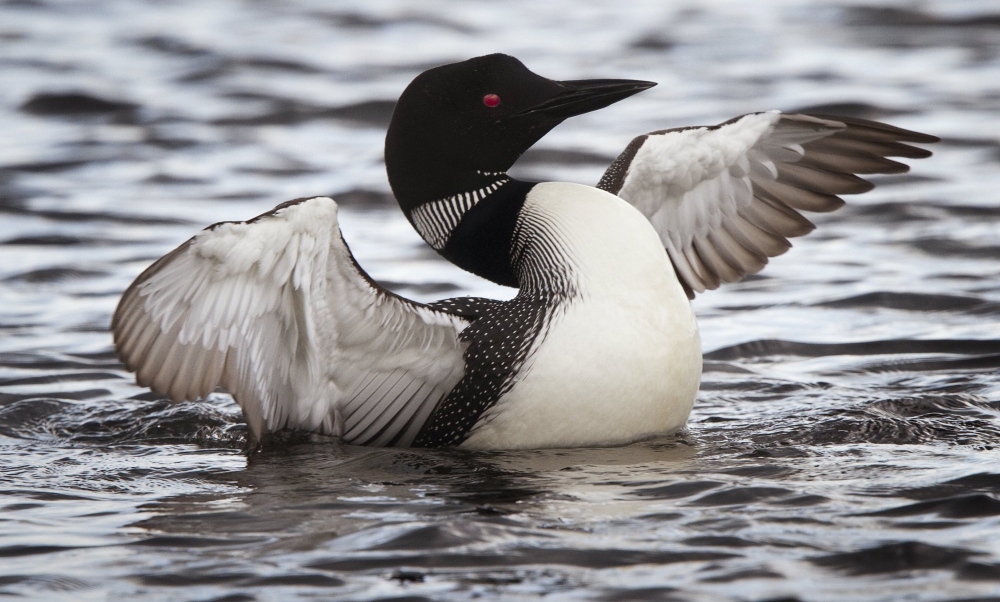More than 20 years ago, environmental media claims caught my eye.
I heard all about how lead fishing sinkers were killing loons, those iconic 9- to 10-pound symbols of the north. These popular birds were ingesting the toxic metal and the scientific research looked solid, leaving little room for doubt.
I belonged to the National Audubon Society so I was on a mailing list that generated environmental pitches. In short, the postal service was delivering more green-leaning mail to me than to average citizens.
After reading the literature, I made one of my “famous” forecasts – famous to me anyway, because my long-term predictions are often wrong. I figured sinkers, jigs and wire made from lead would be illegal for fishing within five years, but the partial ban has taken two decades.
I am strictly a fly rodder and seldom use lead split shot and never lead jigs; however, I was tying weighted nymphs with lead wire on the shank until 1994. That year I immediately stopped the practice cold turkey.
Orvis carried nontoxic weighted wire and split shot, the latter in a holder with a rotating cover for opening individual compartments. Prior to that, a single container held my different-sized lead sinkers all mixed up, so the switch to the safer stuff was pig simple and more convenient for finding the right weight split shot in its own bin.
Being a good citizen contributed to my decision, but also it made sense that within a few years, the government would ban lead split shot – even for flies and fly leaders.
Granted, lead on flies received little bad press in the daily media then (or now), but I figured that right or wrong, lead bans for fishing would soon be the law. I’m pragmatic and very frugal, so back then I didn’t want to tie a bunch of flies with lead wire that might become illegal.
Then, in the first year with my nontoxic weight, an observation wowed me. My weighted flies tied with nontoxic substitutes worked fine and my catch rate didn’t decrease. In fact, within months, using the safer stuff was a complete nonissue to me. I seldom thought about it.
Even more amazing, I knew nontoxic metals on the market were lighter than lead, so I had decided ahead that when dead-drifting a weighted fly, a split shot or two on the leader along with the already weighted nymph would help get my offering to the bottom without heavier lead.
Here are two crucial points in my argument, too:
n I can see the riverbed in two of the rivers that draw me most, and when the light is right and casts are short, it’s easy to see the dead-drifted nymphs kissing bottom – business as usual even without lead.
n Weighted flies (lead or nontoxic) often drift with the hook point up, so they are less apt to snag bottom – another important consideration in the comparison.
Lately, another hot issue in Maine involves terminal tackle. Nonbiodegradable plastic tails are common on bass and a few trout-spinning or bait-casting lures. When these durable, wiggly plastics fall off the lure, they may last in the environment for five to 10 years or even millennia depending on the brand. When fish and birds ingest the nonbiodegradable, wiggly stuff, it may not pass through their digestive system and may stay inside them. Folks might notice the problem when cleaning fish.
Now, manufacturers offer biodegradable plastic for those wiggly tails.
Because of this option, folks with an eye to the future would like to make all lures illegal unless the tail is a biodegradable.
It seems a simple solution to a proven problem, but lately opponents are fighting the change. Some of them claim defining what’s biodegradable can be tricky. I believe science can answer that question, though, and anglers who want to ban plastics with long lifespans are on the right track.
Researchers recognize a potential problem, study it, publish the results and watch for one or two decades and certainly more for political opinion to catch up to the meticulous science behind such conclusions.
Here’s another point: Recently a right-wing zealot and I were discussing the new, partial ban on lead weight, and he verbally attacked me for being a Democrat – an odd response. I’ve never, ever been a member of the Democratic Party, it’s not a partisan issue and I am not a “real” Republican.
I’m a moderate to the core who believes in the magic of bipartisan compromise. When the debate doesn’t get beyond an erroneous accusation about party affiliation, neither side will make much headway.
And to me, nontoxic weight and biodegradable plastic for angling involves just that – compromises. Yes, I may be a consummate bottom-dredger of the fly-fishing world, but I can easily live with lighter, nontoxic metal on days when salmonids or stripers hug bottom in riverine or pond-and-lake habitat.
Ken Allen of Belgrade Lakes, a writer, editor and photographer, may be reached at:
KAllyn800@yahoo.com
Send questions/comments to the editors.



Success. Please wait for the page to reload. If the page does not reload within 5 seconds, please refresh the page.
Enter your email and password to access comments.
Hi, to comment on stories you must . This profile is in addition to your subscription and website login.
Already have a commenting profile? .
Invalid username/password.
Please check your email to confirm and complete your registration.
Only subscribers are eligible to post comments. Please subscribe or login first for digital access. Here’s why.
Use the form below to reset your password. When you've submitted your account email, we will send an email with a reset code.